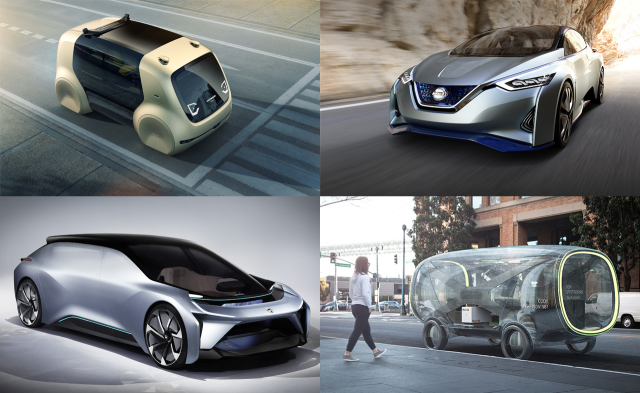Where are we going?
_ustwo Auto’s new book ‘Humanising Autonomy: Where Are We Going?’ explores how human centred design can help tackle barriers to Autonomous Vehicle adoption. In this series of blog posts we will be introducing major themes and insights from the book. _
User research and a human centred design approach form the basis of ustwo’s thinking on autonomy and driverless cars.
The auto industry's approach to autonomy is imbalanced – there is too much focus on the discrete technologies that will enable it, with little regard for the powerful human factors involved.
As the industry gets profoundly disrupted, we firmly believe that it’s not just automotive insiders who have a valuable contribution to make. What’s important is for car makers and service providers to embrace this moment to rethink the design process to transform the entire customer experience for the better, and for everyone.
With that in mind, the rewards will go to those who understand people and their mobility needs – and this requires an approach that puts people at its center.
Our first book made industry predictions, suggested user experience (UX) solutions and offered working practices to help with in-car UX problems. And we’ve been pleased to see some of these adopted in current vehicles. Alfa, for example, returned to a haptic controller in their Giulia – partly because this is the class standard but you could argue that it's rectifying the “slap a touchscreen on it” approach we discussed in our first book.
More recently, we’ve been working on another book – Humanising Autonomy: Where are we going? This time we’re turning our human centred design (HCD) approach to the barriers to adoption facing autonomous vehicles (AVs) and focusing on the new experience challenges that come with it. How can the magic of technology combine with a deeper understanding of how we behave to make the actual experience better and truly adopted by all?
This post serves as an introduction to Humanising Autonomy – which you can now read in full. This book is about the new mindset that’s needed in order to design the experiences of the future. It’s about questions. And about People.
A little background…
In 2013, ustwo Auto embarked upon a new and top secret project for a major OEM (car maker). We were asked to uncover user experience opportunities for improving interactions within the car.
During the project, and afterward whilst researching for a follow-up blog post, we discovered how messy the in-car human-machine interface (HMI) and UX landscape was.
It felt awash with ill-considered menus and inappropriately stylised aesthetics. Something was off. The core (but not the only) reason for this was that the user was absent from the design process and decision making.
So, as you do, we decided to write a book about it. We were new to the auto industry at the time (and still are, relatively speaking) but between us, we had over 40 years’ UX design experience under our seat belts. The skills required to tackle that secret project were similar to those we’ve always used here at ustwo, but the in-car context was all new.

With our UX design focus, we were able to approach the project with a fresh industry perspective – we looked at the in-car UX and UI landscape, studied what was on the market at the time and highlighted user experience gaps.
The book culminated with an in-depth user experience analysis, factoring in legislation, technical limitations, design best practice and, most importantly, the human factors. This gave us the foundations to conclude with a set of design principles on how to design appropriately for the driver.
What we didn’t do, though, was cover how to design for passengers and many others outside of the vehicle who also need to be considered, such as the cyclist or pedestrian. With the advent of driverless cars, the driver may soon be the passenger.
The HCD Challenge for Autonomous Vehicles
Everyone is talking about autonomous driving. From automotive manufacturers, to consumer electronic giants, to software engineers and university lecturers, driverless cars are at the forefront of everyone’s imagination. There were more autonomous driving concepts at CES 2017 than ever before. There is also more money than ever before – in 2016 $1049M was invested across 87 auto tech deals and there was also a record 91% increase in funding.
AVs can make a meaningful difference to the world, enabling a new level of mobility, independence and safety for all. This has been covered in reams of white papers and many 1,000s of articles and news stories all over the globe. From questions of technological feasibility to thorny ethical dilemmas, it’s been approached from many angles.
But there are aspects that haven’t yet been covered – what do people want and need from AVs and how best to design for the many autonomous user experiences – what about those human factors? Even the latest thinking from the US DOT and UK GOV Centre for Connected & Automated Vehicles only cover the driver/passenger and not those around the vehicle, something we address in the book.
I don't think people are thinking about humans in the loop at all right now. Even if we solve autonomous cars, the bigger problem is really humans. Humans are going to mess everything up, and you have to really design for humans using self-driving cars, and how they're going to understand things around them.
We agree with this, though we need to design for this mess rather than bend as humans to suit the machines. In fact, this HCD deficit actually plays to our strengths at ustwo. We can approach this problem using a mixture of established design principles as well as some principles from our very own research.
The contexts where these can be used and how to apply them for the driverless challenge is something we will discuss in more detail throughout the book.
How is this different? Barriers to adoption
There is so much debate happening right now on this topic and having amassed some 50,000 words of notes based on content from press outlets, white papers, specialist conferences, podcasts and even fledging regulation – we see several topics emerging:
- Autonomous concepts. What robots are the OEMs and the tech companies dreaming up? Why do the designs look so sci-fi?
- In the press. Sensationalist headlines demonise or honour the technology.
- Morality and Ethics. Will AVs have to make decisions that humans simply can’t?
- Liability and Insurance. Inevitably things will go wrong, and when they do, who’s to blame?
- Policy and Regulation. What laws are being put in place to govern the technology on our roads?
- The City and Society. What knock-on effects will this technology bring to the way people get around and their way of life?
- The Tech and AI. Deep learning, privacy, hacking – technical feasibility and concerns.
What’s the common theme? They all represent barriers to adoption. OEMs and tech companies alike will need to break through these barriers if they’re to make the new technology a success.
As the rate of cars sales are predicted to slow over the next decade in most of the developed world, OEMs are looking to new and innovative revenue streams. Ford state that mobility services are worth $5.4 trillion. When it comes to new mobility options, OEMs are spreading their bets – and AVs are a front runner. Similarly, technology companies – such as Google, Bosch and Apple – are turning their expertise in consumer electronics and software development to autonomous tech to make a few quid.
So what does this mean for our barriers? Our concern is that they’re being approached without the human in mind: that is, without a HCD approach. To illustrate this, let’s look at point one – autonomous concepts.

There have been some fantastic concepts, with great forms and great ideas, like those above. Notice how none of them have wing (side) mirrors. The exterior/concept designers can do away with wing mirrors because, well, there’s no driver to look into them, opting instead for a smoother more aesthetically pleasing look. So they remove them completely.
However, our research tells us that many of the vision impaired community – potential early adopters of AVs – use wing mirrors to orientate themselves around the vehicle. By feeling for the wing mirror, its shape, its glass panel on one side, the vision impaired are able to establish which way the car is pointing, which side of the car they are standing and therefore where the door is – it’s a physical aid used to enter the vehicle.
So many of these AV designs and concepts that celebrate first time accessibility for the vision impaired, in fact, make it difficult for them to get in at all. The ustwo approach here, after gathering insights like these from user research, speaking to and observing real users from all backgrounds and needs, would be to remove the fully grown wing mirrors to achieve the same aerodynamic and stylistic advantages – like these concepts have – but leave behind something tactile that the vision impaired can rely upon, just like they have already established with their own trusted physical aid.
The final frontier then, the last barrier that all parties concerned will need to overcome before the technology becomes truly adopted is…
- Mobility needs and Human Factors. How do people get around? How do people get from A to B? What is the user experience of acquiring the AV, entering the AV, the journey itself, how the AV interacts with pedestrians, cyclists and manual drivers?
This is the key barrier to adoption and one that has barely been discussed or explored meaningfully. Is autonomous driving technically possible? When will it happen? Is it safe? These are questions that have been asked of the technology time and time again, especially during the last few years. A more important question that has not yet been explored in great detail is:
What do people actually want and need from this technology?
Even this question comes from the tech manufacturers perspective, and not the users themselves. The user doesn’t care, ultimately, about the technology. What they really want is mobility, they want to get from A to B safely and comfortably – the tech simply facilitates and supports that. The big question, therefore, that we are asking is:
What are people’s mobility needs and desires and how can Autonomous Vehicles support them?
Furthermore, how will people adopt and use this technology? Beyond getting in and enjoying the ride – there are far more factors, details and nuances to be considered. What are the human factors at play here and how can we design the best end-to-end connected experience for the person? How would the changing faces of cities, preparing themselves for autonomous transport, affect the people and communities that live within them?
To answer these important questions and to start a constructive debate, we set out to write our second book. We wanted to ensure that it was informed by the right approach, asking the right questions. We wanted to take the HCD approach to writing this book – to demonstrate how important it is to consider the human throughout the development of the product. We felt this has been missing from the debate and we attempt to focus on it.

Human Centred Research
Getting familiar with the AV landscape meant a whole range of things:
- Digesting hundreds of news articles and research papers.
- Studying the numerous AV concepts out there.
- Attending lectures in the UK, Europe and the US.
- Visiting AV testing grounds, including Ann Arbor’s M City, London’s RCA & Greenwich projects as well as UK Autodrive in Coventry, UK.
- We even sat in a brand new autonomous vehicle prototype, on a closed track in a secret location, invited by one of our clients.
Most importantly though, are the things we’ve done that bring us closest to the human side of things. Over the past year, we’ve:
- Worked on mobility and autonomous vehicle projects with OEMs, service providers and councils.
- Invited the public into ustwo workshops and sketch parties in our studios to get their opinions.
- Visited the homes and work spaces of potential future users, from children to the elderly, the tech optimists and those who could lose their jobs as a result of the technology.

Our own research and exercises like these are where we have truly begun to understand what people’s mobility needs are and how AVs can support them.
In recent decades the term "autonomous" has become synonymous with computers and robots and, in more recent years, especially in the tech bubbles of San Francisco, Palo Alto, Cupertino, Shoreditch or Twitter – with driverless cars. Whether it’s Advanced Driver Assistance Systems (ADAS) like cruise control that have been around for decades or the more recent Autonomous Vehicles (AV) such as the Google car plodding along around Mountain View, people hear “autonomous” and think “cars”.
However, step out of the bubble for a second and we quickly remember that the term autonomous has been around far longer than even the car, never mind the driverless car.
Not wanting to be those guys, but the word “autonomous” actually comes from the Greek auto meaning “self” and nomos meaning “law” and originally applies to humans, not machines. After all, the Greeks invented their language ages before modern tech came about – so maybe there's something in that.
Human Autonomy not Robot Autonomy
We use three categories for autonomy… and we make these distinctions in order to foreground what ustwo Auto is all about – human mobility.
- Autonomous Technology (AT). Technology, often with Artificial Intelligence (AI) and Machine learning capabilities, that can perform tasks without the need for intervention from humans.
- Autonomous Vehicle (AV). A form of AT. For example, cars, buses or other means of transport that use AT to provide mobility solutions to people, objects and the city, with no intervention from humans. Note that driverless vehicles are different to autonomous vehicles – some trains are driverless while not fully autonomous. To be classed as a vehicle, an AV must transport people or cargo, with wheels, propellers, huskies and so on.
- Autonomy of People (AP). Now that’s what we’re talking about! We’re interested in how autonomous a person is, which is to a great extent dictated by how independently mobile they are. Mobility is a basic human need. AT and AVs can assist with AP. In this current age, AT and AVs can make for a happier AP.
So here’s our ‘equation’:

We’re concerned with a person’s ability, and even right, to make their own decisions and come and go as they please. Not about how clever cars are without human drivers.
The industry is preoccupied with the race to make their machines be as smart but more safe than human drivers. The press and even many research studies support that, and obviously funding helps direct it that way. What’s really important though, above all else, is how this technology can enable greater human mobility and hence improve their autonomy. For that, we need to consider everything around the vehicle, from human needs to societal implications – not just the vehicle itself.
This thinking has led us to develop a number of design principles for autonomy. Throughout the book, we’ll share more ‘Design Principles’ like this one:
DESIGN PRINCIPLE UNLOCKED:
01. HUMAN AUTONOMY IS THE GOAL
We are creating autonomy for humans; not for the robots. Everything we design is for that human goal, you are not done when the robot is fully autonomous.
You can expect to see them throughout the book, leading us towards helping people with their mobility needs – not making machines more autonomous. Humanising Autonomy will be a handbook for all designers and technologists working in the field.
For this technology to be truly adopted, it must provide greater mobility to people than they had without it. Another way of looking at it is through an egalitarian lens – how many more people can be autonomous with the introduction of this technology when compared to the state of play today. For instance, can it provide greater mobility to people living on the fringes of society due to economic, physical or even social reasons – the vision impaired, the elderly or even the homeless?
We’d like to invite and open up this debate with the community as we have done with all our previous work. We hope that our research and thinking in this book will help enlighten and encourage OEMs, tier one and two suppliers, local authorities, policy makers and even the users of this tech to consider the human at the heart of all their decision making.
We will be sharing further insights from the book before the full release, so keep an eye on our blog for more – the next post will explore more deeply the human impact of this technology. We will be exploring people and autonomy – sharing what autonomy means to the individuals, who come from all different walks of life, that we have interviewed and observed.
So far, we hope you enjoyed this read – and remember to you can download a complete copy of the book here.
You can also check out more work from ustwo Auto here and contact us mobility@ustwo.com.
